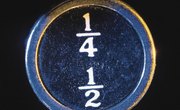
When you add or subtract two fractions, both fractions must have the same denominators. But for multiplying or dividing fractions, the denominators don't matter at all. When you multiply, you simply work straight across the fraction, multiplying all the numerators together and then all the denominators together. Dividing fractions works exactly the same, with the addition of one more step at the beginning.
TL;DR (Too Long; Didn't Read)
To divide fractions, regardless of the denominators, flip the second fraction (the divisor) upside down and then multiply the result with the first fraction (the dividend).
So a/b ÷ c/d = a/b × d/c = ad/bc
Review: Multiplying Fractions With Different Denominators
Before you go on to dividing fractions, take a moment to review the process for multiplying fractions. You're going to need this skill for working division problems, too.
If you're presented with a multiplication problem of the form
it doesn't matter what the denominators are. All you have to do is multiply the numerators together and write those as the numerator of your answer; then multiply the denominators together and multiply those as the denominator of your answer.
Example 1: Calculate
Remember, for multiplication, it doesn't matter if your fractions have the same denominators. All you have to do is multiply straight across, which gives you:
which when simplified gives you:
If you can simplify your answer by canceling factors from both numerator and denominator, you should. But in this case you cannot simplify further, so your full answer is:
Now on to Dividing Fractions
Now that you've reviewed how to multiply fractions, dividing fractions works almost the same – you just have to add one extra step. Flip the second fraction (also known as the divisor) upside down, and then change the operation to multiplication instead of division.
So if your original division problem looks like this:
The first thing you do is flip the second fraction upside down, making it d/c; then change the division sign to a multiplication sign, which gives you:
And because you practiced multiplying fractions, you know how to solve this. Just multiply across the numerators and the denominators, which gives you a result of:
Two Examples of Dividing Fractions
Now that you know the process for dividing fractions, it's time to practice with a couple of examples.
Example 2: Calculate
Remember, your first step is to flip the second fraction upside down, and change the operation to multiplication. This gives you:
Now, just multiply across and simplify:
So
Example 3: Calculate
Note that one of these fractions is improper (its numerator is larger than its denominator). But that doesn't change the process for dividing fractions, so flip that second fraction upside down and change the operation to multiplication:
As before, multiply across and simplify if you can:
77 and 50 don't share any common factors, so you can't simplify any further. So your final answer is:
A Trick for Remembering
If you struggle to remember this, it might help to recall that multiplication and division are reciprocal operations; that is, one undoes the other. When you flip a fraction upside down, that's called a reciprocal, too. So d/c is the reciprocal of c/d, and vice versa.
That means that when you divide a fraction, you're actually performing the reciprocal operation on a reciprocal fraction. Both of those reciprocals have to be there for the problem to work out. If you only have one of them – say, if you did the reciprocal operation (multiplying) without first taking the reciprocal of that second fraction – your answer would not be correct.
Tips
Okay – there is ONE extra rule to keep your eye on when it comes to which fractions you can and can't divide. Just as you can't divide whole numbers by zero, you also can't divide a fraction by zero; the result is undefined. If you forget this, you'll be reminded pretty quickly if you try to work a problem such as 5/6 ÷ 0/2. That's because normally, you'd flip the second fraction over and multiply: 5/6 × 2/0. But you can't have zero in the denominator of a fraction; that, too, is considered undefined.
What About Dividing Mixed Numbers?
If you're asked to divide mixed numbers, watch out – it's a trap! Before you can proceed, you have to convert that mixed number to an improper fraction. Once that's done, you follow the exact same process you'd use for proper fractions. See Example 3, above, for an illustration of how that works. It includes an improper fraction, 11/10, which could also be written as the mixed number 1 1/10.
References
About the Author
Lisa studied mathematics at the University of Alaska, Anchorage, and spent several years tutoring high school and university students through scary -- but fun! -- math subjects like algebra and calculus.
